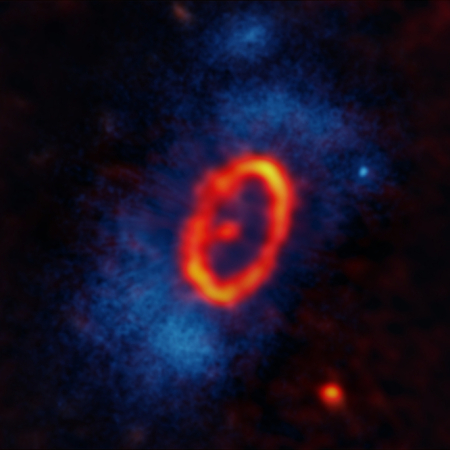An eccentric debris disk circling a nearby star

Using the Atacama Large Millimeter/submillimeter Array (ALMA) in Chile, astronomers have discovered that the debris disk surrounding a star about 60 light years away, discovered in 2006 by the Hubble Space Telescope, is not circular, but instead forms an eccentric ring about the star.
The photo to the right combines the Hubble data (the blue background) and the ALMA data (the orange-yellow ring). The star is the bright spot in the ring, not in its center but at one of the ellipse’s two foci.
This level of eccentricity, MacGregor said, makes HD 53143 the most eccentric debris disk observed to date, being twice as eccentric as the Fomalhaut debris disk, which MacGregor fully imaged at millimeter wavelengths using ALMA in 2017. “So far, we have not found many disks with a significant eccentricity. In general, we don’t expect disks to be very eccentric unless something, like a planet, is sculpting them and forcing them to be eccentric. Without that force, orbits tend to circularize, like what we see in our own Solar System.”
In other words, there must be at least one hidden planet, maybe more, orbiting the star, its gravity forcing the disk into this shape.
On Christmas Eve 1968 three Americans became the first humans to visit another world. What they did to celebrate was unexpected and profound, and will be remembered throughout all human history. Genesis: the Story of Apollo 8, Robert Zimmerman's classic history of humanity's first journey to another world, tells that story, and it is now available as both an ebook and an audiobook, both with a foreword by Valerie Anders and a new introduction by Robert Zimmerman.
The print edition can be purchased at Amazon or from any other book seller. If you want an autographed copy the price is $60 for the hardback and $45 for the paperback, plus $8 shipping for each. Go here for purchasing details. The ebook is available everywhere for $5.99 (before discount) at amazon, or direct from my ebook publisher, ebookit. If you buy it from ebookit you don't support the big tech companies and the author gets a bigger cut much sooner.
The audiobook is also available at all these vendors, and is also free with a 30-day trial membership to Audible.
"Not simply about one mission, [Genesis] is also the history of America's quest for the moon... Zimmerman has done a masterful job of tying disparate events together into a solid account of one of America's greatest human triumphs."--San Antonio Express-News

Using the Atacama Large Millimeter/submillimeter Array (ALMA) in Chile, astronomers have discovered that the debris disk surrounding a star about 60 light years away, discovered in 2006 by the Hubble Space Telescope, is not circular, but instead forms an eccentric ring about the star.
The photo to the right combines the Hubble data (the blue background) and the ALMA data (the orange-yellow ring). The star is the bright spot in the ring, not in its center but at one of the ellipse’s two foci.
This level of eccentricity, MacGregor said, makes HD 53143 the most eccentric debris disk observed to date, being twice as eccentric as the Fomalhaut debris disk, which MacGregor fully imaged at millimeter wavelengths using ALMA in 2017. “So far, we have not found many disks with a significant eccentricity. In general, we don’t expect disks to be very eccentric unless something, like a planet, is sculpting them and forcing them to be eccentric. Without that force, orbits tend to circularize, like what we see in our own Solar System.”
In other words, there must be at least one hidden planet, maybe more, orbiting the star, its gravity forcing the disk into this shape.
On Christmas Eve 1968 three Americans became the first humans to visit another world. What they did to celebrate was unexpected and profound, and will be remembered throughout all human history. Genesis: the Story of Apollo 8, Robert Zimmerman's classic history of humanity's first journey to another world, tells that story, and it is now available as both an ebook and an audiobook, both with a foreword by Valerie Anders and a new introduction by Robert Zimmerman.
The print edition can be purchased at Amazon or from any other book seller. If you want an autographed copy the price is $60 for the hardback and $45 for the paperback, plus $8 shipping for each. Go here for purchasing details. The ebook is available everywhere for $5.99 (before discount) at amazon, or direct from my ebook publisher, ebookit. If you buy it from ebookit you don't support the big tech companies and the author gets a bigger cut much sooner.
The audiobook is also available at all these vendors, and is also free with a 30-day trial membership to Audible.
"Not simply about one mission, [Genesis] is also the history of America's quest for the moon... Zimmerman has done a masterful job of tying disparate events together into a solid account of one of America's greatest human triumphs."--San Antonio Express-News


If the ring forms an ellipse — and the star visible within that ring is deemed to be located at (one of) the focus(es) of that ellipse — then for that to be true, the ring-ellipse must actually be angled toward (or away) from us at a considerable angle. It can be nowhere close to face-on.
If it takes a star to form one focus of the ellipse, could a co-orbiting brown dwarf be at the other focus? Also curious about the color rendition. If the colors correspond to energy, then the debris ring appears to be as energetic, if not more so, than the visible star.